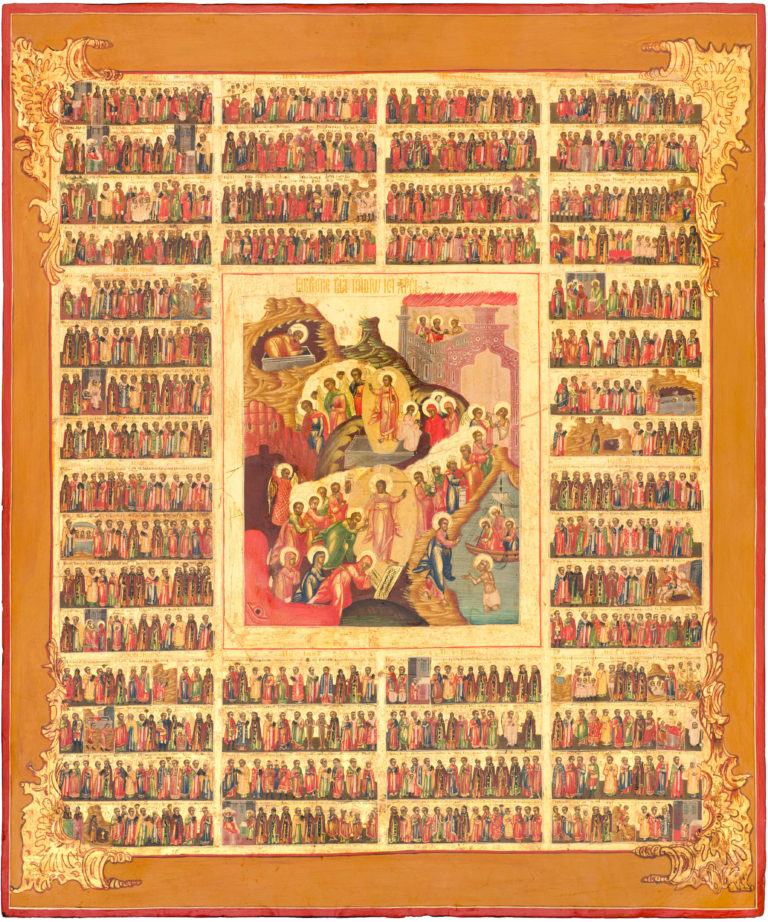The Resurrection—the Descent into Hell, with the Yearly Menaion
Antique Russian icon. Second half of the 19th century (1870s-1880s). Icon-painting villages of the Vladimir region (Palekh).
Size: 45 х 37 х 2.5 cm
Wood (two panels), two incut support boards (now lost), absence of the incut centerpiece, underlying layer of canvas not visible, gesso, tempera, gold.
The author’s paintwork is in an overall good condition with only several small fallouts of paint. Restoration toning and various insertions on the borders.
Contact us

The Resurrection—the Descent into Hell, with the Yearly Menaion
Diagram of the border scenes:
- The September Menaion;
- The October Menaion;
- The November Menaion;
- The December Menaion;
- The January Menaion;
- The February Menaion;
- The March Menaion;
- The April Menaion;
- The May Menaion;
- The June Menaion;
- The July Menaion;
- The August Menaion.
The Imperial period saw the appearance of new “compilation” religious icons that brought together various scenes, narratives, saints, and Marian images on a single panel. Such compositions, retaining the traditional “Resurrection – Harrowing of Hades” scene in the centerpiece, often included the Menaion – monthly compilations of saints and Feasts for every month depicted in several rows according to their celebration day. These universal “calendar” hand-painted Orthodox icons were increasingly popular in the second half of the 19th century.
“The Resurrection – The Harrowing of Hades” scene belongs to the complex iconographic variation that includes two main scenes – the Rising from the Tomb and the Harrowing of Hades – placed along a single axis and united by two diagonal processions, the Pious marching into Heaven and the Angels descending to the Gates of Hell. The number of additional scenes is brought to the minimum: in the upper right corner, we see “Saint Peter before the Empty Tomb,” in the lower right – “The Revelation of Christ to the Apostles on the Sea of Galilee.” The Menaion border scenes of this antique Russian icon are traditionally in a line-by-line, left-to-right chronological order, following the Church (not the secular) calendar and beginning with September – the start of the Orthodox liturgical year. The Menaion Eastern Orthodox icons were mostly based on etchings made in the first quarter of the 18th century by Gregorii Tepchegorskii. Each border scene is split into four tiers with a respective number of Feasts and saints. The miniature size of the border scene naturally leads to the simplification of the iconographic schemes, the number of which is also brought to the minimum. Here we see only the main events of the liturgical year. The composition often includes only one or two main figures (“The Nativity of the Mother of God” – September 8th, “The Feast of the Archangel Gabriel” – March 26th, “The Nativity of John the Baptist” – June 24th, “The Deposition of the Robe of the Mother of God” – July 2nd, “The Deposition of the Belt of the Mother of God” – August 31st, all dates by the Julian calendar). The frame that separates the border scenes from the religious icon centerpiece is decorated with golden Rococo cartouches.
The small size and overcrowded composition of the given antique Russian icon attest to the fact that it was commissioned and used for private prayer, as a form of a home calendar. The miniature religious icon painting style, the resonating colors, and the almost enamel-like quality of the paint enforced by the dense gold background give this antique icon the air of preciousness. The piece finds close analogies among the later-period Palekh religious icon paintings (1870s-1880s). One of them is the hand-painted icon of the Resurrection with the Passion cycle painted in the second half of the 19th century by Mikhail Zinoviev and Vasiliy Markichev (now kept in the State Palekh Art Museum). It is possible that the given antique icon was painted in one of the Palekh’s workshops, specializing in “miniature” painting (for example, in the workshops of Alexander Korovaikin or Phinogen Nanykin, both known since the 1860s).